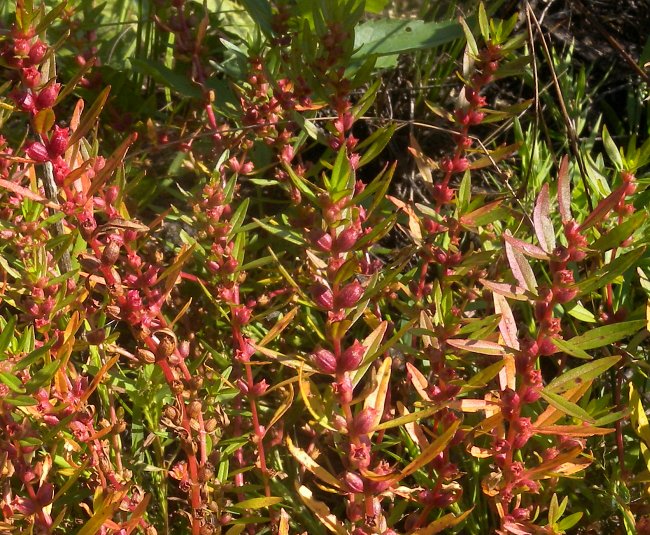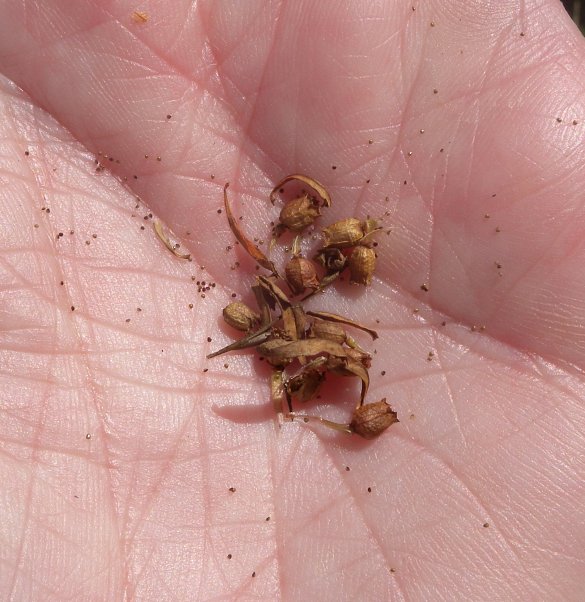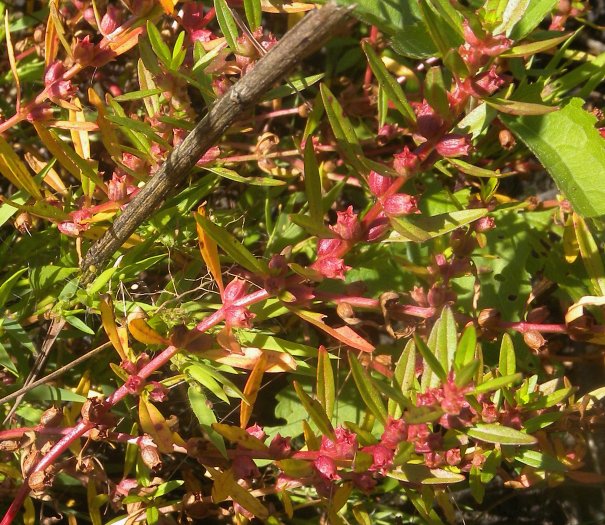Wheelwort
Rotala ramosior
Loosestrife family (Lythraceae)
Rotala ramosior
Loosestrife family (Lythraceae)
Description:
This herbaceous
plant is a summer annual that becomes 4–18" (10–45 cm.) tall.
Individual plants are either unbranched, or they branch toward the
base; their leafy stems are usually erect or ascending, but sometimes
they sprawl. Stems are light green to red, 4-angled, and
hairless. Numerous pairs of spreading to ascending opposite leaves
occur along the
entire length of each stem. These leaves are ¾–1½" (2–4 cm.) long and
¼" (6 mm.) or less across; they are narrowly elliptic to narrowly
elliptic-oblanceolate in shape with toothless (entire) margins. The
leaves have short tips, while their bases are more
or less sessile. The leaf surfaces are light green to light red,
depending
on the time of year and exposure to light; they are also hairless. Each
leaf has a prominent midvein. Solitary flowers develop from the
lower-middle to upper leaf axils; they are sessile or nearly so.

Each flower spans a little less than ¼" across (about 4–5 mm.), consisting of an upright barrel-shaped calyx with 4 tiny deltate (triangular) lobes, 0 or 4 tiny petals (about 1 mm. long when they are present) that are white to light pink and early-deciduous, 4 inserted stamens, and a pistil with a short style that is inserted with the calyx. The calyx itself is light green to red (depending on its maturity and light exposure) and few-ribbed. The blooming period occurs from midsummer to autumn, lasting about 2–3 months. Only a few flowers are in bloom at the same time toward the apex of each leafy stem as the plant grows. In the absence of cross-pollination, the flowers are self-fertile. Afterwards, the flowers are gradually replaced by seed capsules that remain enclosed within their calyces. At maturity, these turn brown and the seed capsules split open. Each seed capsule contains numerous tiny seeds (about 0.3–0.5 mm. long). These seeds can be blown about by wind or carried by water. The root system of this plant is shallow and fibrous. This plant reproduces by reseeding itself.

Cultivation: The preference is partial to full sun, wet to moist conditions (including shallow standing water during the spring), soil containing sand or gravelly material with decaying organic matter, and a pH of about 6–7.5. The seeds normally germinate during winter or early spring (a period of cold temperatures in damp conditions is required for germination). Growth and development occurs for the remainder of the year until hard frost in autumn. Stored away from damp soil, the tiny seeds remain viable for up to a year, but when they are contained in damp soil they can remain viable for up to 10 years.
Range & Habitat: Wheelwort (Rotala ramosior) has scattered populations throughout Illinois, where it is native and occasional (see Distribution Map). It is widely distributed in North America, also occurring in some areas of South America and the Caribbean islands. Habitats include moist depressions (swales) in sand prairies, wet sand prairies, rocky depressions in sandstone glades, borders of ponds and springs, acidic gravelly seeps, ditches, mudflats, excavated land, and seasonal wetlands of all kinds. Low-nutrient seasonal wetlands are where this plant is most common; it can occur in both high quality natural areas and more disturbed areas. Because Wheelwort is an annual plant that responds to variations in water moisture, its populations can vary considerably in size from year-to-year.

Faunal Associations: Very little is known about floral-faunal relationships for Wheelwort (Rotala ramosior), so the following information is somewhat speculative. Because it is closely related to the more common Scarlet Toothcup (Ammannia coccinea) and occupies similar habitats, the flowers of Wheelwort probably attract similar pollinating insects, such as small bees, flies (especially Syrphidae), and less often small butterflies or skippers. When this small plant occurs along bodies of water, it seed capsules may be eaten by ducks. Canada Geese may also eat the foliage and seed capsules, as this plant is not known to be toxic. In pastures where there are wetlands, this plant may be browsed by cattle and other livestock.
Photographic Location: A swale (wet depression) in a sand prairie at Bonnie's Prairie Nature Preserve in Iroquois County, Illinois.

Comments: This interesting wetland plant has received little attention in the past because of its small size and non-showy flowers. However, the foliage and seed capsules can assume an attractive bright red color when they are exposed to bright sunny conditions. Wheelwort (Rotala ramosior) is similar in appearance to the more common Scarlet Toothcup (Ammannia coccinea). Wheelwort differs from the latter species by having leaves that are more or less sessile, rather than clasping the stems; and by producing only solitary flowers (or seed capsules) from the axils of the leaves, rather than flowers (or seed capsules) in clusters of 2 or more. Unlike Scarlet Toothcup, sometimes the flowers of Wheelwort have white petals or they lack petals altogether. There are also minor structural differences in their respective calyces, inner seed capsules, and seeds. The common name, Wheelwort, comes from the Latin word, Rotala, in the scientific name, which means 'wheel.' This is because other Rotala spp. have whorled leaves, like the spokes of a wheel, although the Wheelwort in Illinois does not. Another common name that is often applied to this plant is Lowland Toothcup.

Each flower spans a little less than ¼" across (about 4–5 mm.), consisting of an upright barrel-shaped calyx with 4 tiny deltate (triangular) lobes, 0 or 4 tiny petals (about 1 mm. long when they are present) that are white to light pink and early-deciduous, 4 inserted stamens, and a pistil with a short style that is inserted with the calyx. The calyx itself is light green to red (depending on its maturity and light exposure) and few-ribbed. The blooming period occurs from midsummer to autumn, lasting about 2–3 months. Only a few flowers are in bloom at the same time toward the apex of each leafy stem as the plant grows. In the absence of cross-pollination, the flowers are self-fertile. Afterwards, the flowers are gradually replaced by seed capsules that remain enclosed within their calyces. At maturity, these turn brown and the seed capsules split open. Each seed capsule contains numerous tiny seeds (about 0.3–0.5 mm. long). These seeds can be blown about by wind or carried by water. The root system of this plant is shallow and fibrous. This plant reproduces by reseeding itself.

Cultivation: The preference is partial to full sun, wet to moist conditions (including shallow standing water during the spring), soil containing sand or gravelly material with decaying organic matter, and a pH of about 6–7.5. The seeds normally germinate during winter or early spring (a period of cold temperatures in damp conditions is required for germination). Growth and development occurs for the remainder of the year until hard frost in autumn. Stored away from damp soil, the tiny seeds remain viable for up to a year, but when they are contained in damp soil they can remain viable for up to 10 years.
Range & Habitat: Wheelwort (Rotala ramosior) has scattered populations throughout Illinois, where it is native and occasional (see Distribution Map). It is widely distributed in North America, also occurring in some areas of South America and the Caribbean islands. Habitats include moist depressions (swales) in sand prairies, wet sand prairies, rocky depressions in sandstone glades, borders of ponds and springs, acidic gravelly seeps, ditches, mudflats, excavated land, and seasonal wetlands of all kinds. Low-nutrient seasonal wetlands are where this plant is most common; it can occur in both high quality natural areas and more disturbed areas. Because Wheelwort is an annual plant that responds to variations in water moisture, its populations can vary considerably in size from year-to-year.

Faunal Associations: Very little is known about floral-faunal relationships for Wheelwort (Rotala ramosior), so the following information is somewhat speculative. Because it is closely related to the more common Scarlet Toothcup (Ammannia coccinea) and occupies similar habitats, the flowers of Wheelwort probably attract similar pollinating insects, such as small bees, flies (especially Syrphidae), and less often small butterflies or skippers. When this small plant occurs along bodies of water, it seed capsules may be eaten by ducks. Canada Geese may also eat the foliage and seed capsules, as this plant is not known to be toxic. In pastures where there are wetlands, this plant may be browsed by cattle and other livestock.
Photographic Location: A swale (wet depression) in a sand prairie at Bonnie's Prairie Nature Preserve in Iroquois County, Illinois.

Comments: This interesting wetland plant has received little attention in the past because of its small size and non-showy flowers. However, the foliage and seed capsules can assume an attractive bright red color when they are exposed to bright sunny conditions. Wheelwort (Rotala ramosior) is similar in appearance to the more common Scarlet Toothcup (Ammannia coccinea). Wheelwort differs from the latter species by having leaves that are more or less sessile, rather than clasping the stems; and by producing only solitary flowers (or seed capsules) from the axils of the leaves, rather than flowers (or seed capsules) in clusters of 2 or more. Unlike Scarlet Toothcup, sometimes the flowers of Wheelwort have white petals or they lack petals altogether. There are also minor structural differences in their respective calyces, inner seed capsules, and seeds. The common name, Wheelwort, comes from the Latin word, Rotala, in the scientific name, which means 'wheel.' This is because other Rotala spp. have whorled leaves, like the spokes of a wheel, although the Wheelwort in Illinois does not. Another common name that is often applied to this plant is Lowland Toothcup.